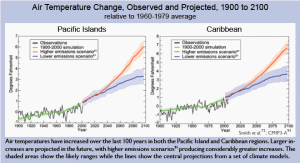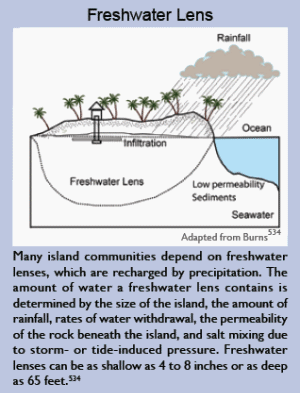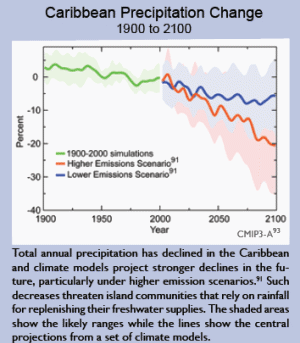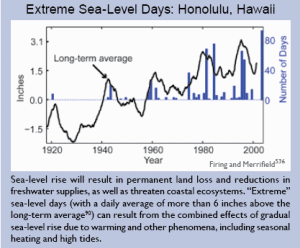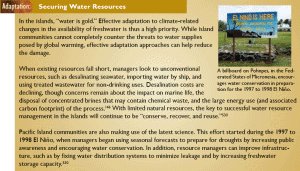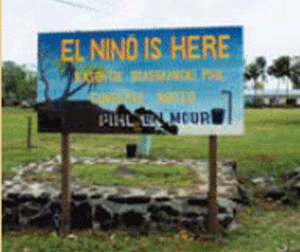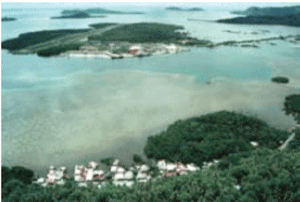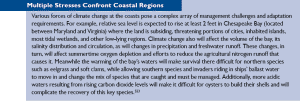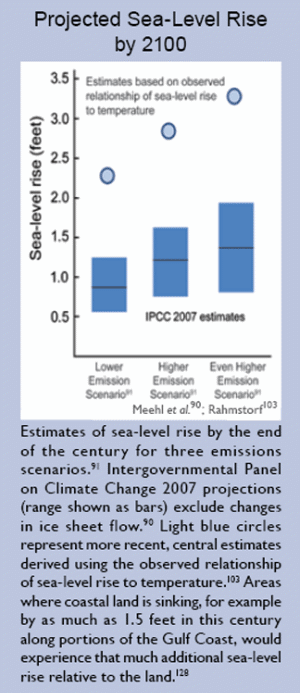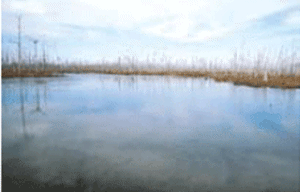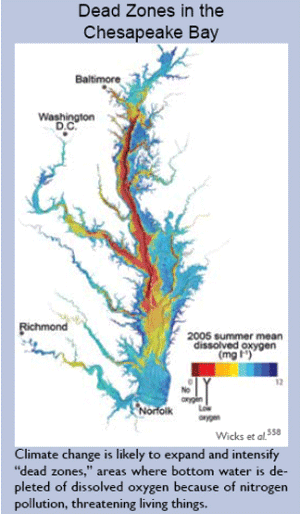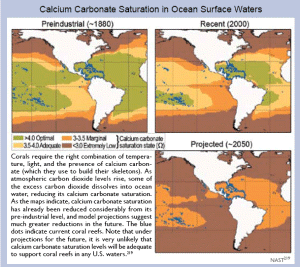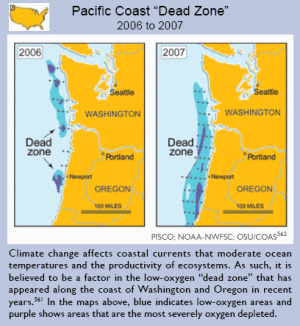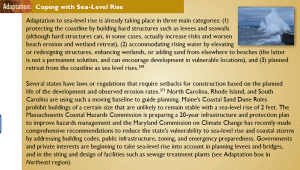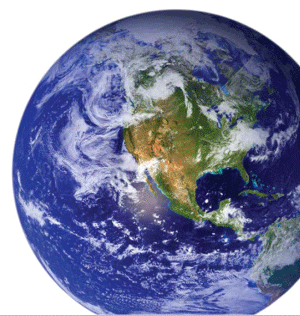Part 3 of 4
231 U.S. Environmental Protection Agency, 2008: Inventory of U.S. Greenhouse Gas Emissions and Sinks: 1990-2006. USEPA 430-R- 08-005. U.S. Environmental Protection Agency, Washington, DC, 473 pp. <http://www.epa.gov/climatechange/emissions/usinvent oryreport.html>
232 National Agricultural Statistics Service, 2002: 2002 Census of Agriculture. USDA National Agricultural Statistics Service, Washington, DC. <http://www.agcensus.usda.gov/Publications/2002/ index.asp>
233 Wolfe, W., L. Ziska, C. Petzoldt, A. Seaman, L. Chase, and K. Hayhoe, 2007: Projected change in climate thresholds in the northeastern U.S.: implications for crops, pests, livestock, and farmers. Mitigation and Adaptation Strategies for Global Change, 13(5-6), 555-575.
234 Frumhoff, P.C., J.J. McCarthy, J.M. Melillo, S.C. Moser, and D.J. Wuebbles, 2007: Confronting Climate Change in the U.S. Northeast: Science, Impacts and Solutions. Synthesis report of the Northeast Climate Impacts Assessment. Union of Concerned Scientists, Cambridge, MA, 146 pp.
235 Gu, L., P.J. Hanson, W.M. Post, D.P. Kaiser, B. Yang, R. Nemani, S.G. Pallardy, and T. Meyers, 2008: The 2007 eastern U.S. spring freeze: increased cold damage in a warming world? BioScience, 58(3), 253-262.
236 Inouye, D.W., 2008: Effects of climate change on phenology, frost damage, and floral abundance of montane wildflowers. Ecology, 89(2), 353-362.
237 Either hydrogen dioxide or oxygenated hydrocarbons.
238 Peet, M.M. and D.W. Wolf, 2000: Crop ecosystem responses to climate change: vegetable crops. In: Climate Change and Global Crop Productivity [Reddy, K.R. and H.F. Hodges (eds.)]. CABI Publishing, New York, and Wallingford, UK, 472 pp.
239 Bridges, D.C. (ed.), 1992: Crop Losses Due to Weeds in the United States. Weed Science Society of America, Champaign, IL, 403 pp.
240 Joyce, L.A., G.M. Blate, J.S. Littell, S.G. McNulty, C.I. Millar, S.C. Moser, R.P. Neilson, K. O’Halloran, and D.L. Peterson, 2008: National forests. In: Preliminary Review of Adaptation Options for Climate-sensitive Ecosystems and Resources. [Julius, S.H., J.M. West (eds.), J.S. Baron, B. Griffith, L.A. Joyce, P. Kareiva, B.D. Keller, M.A. Palmer, C.H. Peterson, and J.M. Scott (authors)]. Synthesis and Assessment Product 4.4. U.S. Environmental Protection Agency, Washington, DC, pp. 3-1 to 3-127.
241 Kiely, T., D. Donaldson, and A. Grube, 2004: Pesticides Industry Sales and Usage: 2000 and 2001 Market Estimates. U.S. Environmental Protection Agency, Washington, DC, 33 pp. <http://www. epa.gov/oppbead1/pestsales/>
242 Natural Resources Conservation Service, 1997: 1997 Five-Year Natural Resources Inventory. USDA Natural Resources Conservation Service, Washington, DC. <http://www.nrcs.usda.gov/technical/ NRI/1997/index.html>
243 Ryan, M.G., S.R. Archer, R. Birdsey, C. Dahm, L. Heath, J. Hicke, D. Hollinger, T. Huxman, G. Okin, R. Oren, J. Randerson, and W. Schlesinger, 2008: Land resources. In: The Effects of Climate Change on Agriculture, Land Resources, Water Resources, and Biodiversity in the United States [Backlund, P., A. Janetos, D. Schimel, J. Hatfield, K. Boote, P. Fay, L. Hahn, C. Izaurralde, B.A. Kimball, T. Mader, J. Morgan, D. Ort, W. Polley, A. Thomson, D. Wolfe, M.G. Ryan, S.R. Archer, R. Birdsey, C. Dahm, L. Heath, J. Hicke, D. Hollinger, T. Huxman, G. Okin, R. Oren, J. Randerson, W. Schlesinger, D. Lettenmaier, D. Major, L. Poff, S. Running, L. Hansen, D. Inouye, B.P. Kelly, L. Meyerson, B. Peterson, and R. Shaw (eds.)]. Synthesis and Assessment Product 4.3. U.S. Department of Agriculture, Washington, DC, pp. 75-120.
244 Parmesan, C., 1996: Climate and species range. Nature, 382(6594), 765-766.
245 Hinzman, L.D., N.D. Bettez, W.R. Bolton, F.S. Chapin, M.B. Dyurgerov, C.L. Fastie, B. Griffith, R.D. Hollister, A. Hope, H.P. Huntington, A.M. Jensen, G.J. Jia, T. Jorgenson, D.L. Kane, D.R. Klein, G. Kofinas, A.H. Lynch, A.H. Lloyd, A.D. McGuire, F.E. Nelson, M. Nolan, W.C. Oechel, T.E. Osterkamp, C.H. Racine, V.E. Romanovsky, R.S. Stone, D.A. Stow, M. Sturm, C.E. Tweedie, G.L. Vourlitis, M.D. Walker, D.A. Walker, P.J. Webber, J.M. Welker, K.S. Winker, and K. Yoshikawa, 2005: Evidence and implications of recent climate change in northern Alaska and other Arctic regions. Climatic Change, 72(3), 251-298.
246 Mimura, N., L. Nurse, R.F. McLean, J. Agard, L. Briguglio, P. Lefale, R. Payet, and G. Sem, 2007: Small islands. In: Climate Change 2007: Impacts, Adaptation and Vulnerability. Contribution of Working Group II to the Fourth Assessment Report of the Intergovernmental Panel on Climate Change [Parry, M.L., O.F. Canziani, J.P. Palutikof, P.J. van der Linden, and C.E. Hanson (eds.)]. Cambridge University Press, Cambridge, UK, and New York, pp. 687-716.
247 Millennium Ecosystem Assessment, 2005: Ecosystems and Human Well-being: Biodiversity Synthesis. World Resources Institute, Washington, DC, 86 pp. <http://www.millenniumassessment.org>
248 Fischlin, A., G.F. Midgley, J.T. Price, R. Leemans, B. Gopal, C. Turley, M.D.A. Rounsevell, O.P. Dube, J. Tarazona, and A.A. Velichko, 2007: Ecosystems, their properties, goods, and services. In: Climate Change 2007: Impacts, Adaptation and Vulnerability. Contribution of Working Group II to the Fourth Assessment Report of the Intergovernmental Panel on Climate Change [Parry, M.L., O.F. Canziani, J.P. Palutikof, P.J. van der Linden and C.E. Hanson (eds.)]. Cambridge University Press, Cambridge, UK, and New York, pp. 211-272.
249 National Interagency Fire Center, [2008]: Total Wildland Fires and Acres (1960-2007). National Interagency Coordination Center, Boise, ID. Data at <http://www.nifc.gov/fire_info/fire_stats.htm>
250 CCSP, 2009: Case studies. In: Thresholds of Climate Change in Ecosystems [Fagre, D.B., C.W. Charles, C.D. Allen, C. Birkeland, F.S. Chapin III, P.M. Groffman, G.R. Guntenspergen, A.K. Knapp, A.D. McGuire, P.J. Mulholland, D.P.C. Peters, D.D. Roby, and G. Sugihara] Synthesis and Assessment Product 4.2. U.S. Geological Survey, Reston, VA, pp. 32-73.
251 Pounds, J.A., M.R. Bustamante, L.A. Coloma, J.A. Consuegra, M.P. L. Fogden, P.N. Foster, E. La Marca, K.L. Masters, A. Merino-Viteri, R. Puschendorf, S.R. Ron, G.A. Sánchez-Azofeifa, C.J. Still, and B.E. Young, 2006: Widespread amphibian extinctions from epidemic disease driven by global warming. Nature, 439(7073), 161-167.
252 Peterson, T.C., D.M. Anderson, S.J. Cohen, M. Cortez-Vázquez, R.J. Murnane, C. Parmesan, D. Phillips, R.S. Pulwarty, and J.M.R. Stone, 2008: Why weather and climate extremes matter. In: Weather and Climate Extremes in a Changing Climate. Regions of Focus: North America, Hawaii, Caribbean, and U.S. Pacific Islands [Karl, T.R., G.A. Meehl, C.D. Miller, S.J. Hassol, A.M. Waple, and W.L. Murray (eds.)]. Synthesis and Assessment Product 3.3. U.S. Climate Change Science Program, Washington, DC, pp. 11-34.
253 Backlund, P., D. Schimel, A. Janetos, J. Hatfield, M.G. Ryan, S.R. Archer, and D. Lettenmaier, 2008: Introduction. In: The Effects of Climate Change on Agriculture, Land Resources, Water Resources, and Biodiversity in the United States [Backlund, P., A. Janetos, D. Schimel, J. Hatfield, K. Boote, P. Fay, L. Hahn, C. Izaurralde, B.A. Kimball, T. Mader, J. Morgan, D. Ort, W. Polley, A. Thomson, D. Wolfe, M.G. Ryan, S.R. Archer, R. Birdsey, C. Dahm, L. Heath, J. Hicke, D. Hollinger, T. Huxman, G. Okin, R. Oren, J. Randerson, W. Schlesinger, D. Lettenmaier, D. Major, L. Poff, S. Running, L. Hansen, D. Inouye, B.P. Kelly, L. Meyerson, B. Peterson, and R. Shaw (eds.)]. Synthesis and Assessment Product 4.3. U.S. Department of Agriculture, Washington, DC, pp. 11-20.
254 Burkett, V.R., D.A. Wilcox, R. Stottlemeyer, W. Barrow, D. Fagre, J. Baron, J. Price, J.L. Nielsen, C.D. Allen, D.L. Peterson, G. Ruggerone, and T. Doyle, 2005: Nonlinear dynamics in ecosystem response to climatic change: case studies and policy implications. Ecological Complexity, 2(4), 357-394.
255 Anderson, K.E., D.R. Cahoon, S.K. Gill, B.T. Gutierrez, E.R. Thieler, J.G. Titus, and S.J. Williams, 2009: Executive summary. In: Coastal Elevations and Sensitivity to Sea-level Rise: A Focus on the Mid-Atlantic Region [J.G. Titus (coordinating lead author), K.E. Anderson, D.R. Cahoon, D.B. Gesch, S.K. Gill, B.T. Gutierrez, E.R. Thieler, and S.J. Williams (lead authors)]. Synthesis and Assessment Product 4.1. U.S. Environmental Protection Agency, Washington, DC, pp. 1-8.
256 Park, R.A., M.S. Trehan, P.W. Mausel, and R.C. Howe, 1989: The Effects of Sea Level Rise on U.S. Coastal Wetlands. U.S. Environmental Protection Agency, Washington, DC, 55 pp.
257 Gutierrez, B.T., S.J. Williams, and E.R Thieler, 2009: Ocean coasts. In: Coastal Elevations and Sensitivity to Sea-level Rise: A Focus on the Mid-Atlantic Region [J.G. Titus (coordinating lead author), K.E. Anderson, D.R. Cahoon, D.B. Gesch, S.K. Gill, B.T. Gutierrez, E.R. Thieler, and S.J. Williams (lead authors)]. Synthesis and Assessment Product 4.1. U.S. Environmental Protection Agency, Washington, DC, pp. 43-56.
258 Monaco Declaration, 2009: Developed at the Second International Symposium on the Ocean in a High-CO2 World, Monaco, 6-9 October 2008. <http://ioc3.unesco.org/oanet/Symposium2008/Mo nacoDeclaration.pdf>
259 Feely, R.A., C.L. Sabine, J.M. Hernandez-Ayon, D. Ianson, and B. Hales, 2008: Evidence for upwelling of corrosive “acidified” water onto the continental shelf. Science, 320(5882), 1490-1492.
260 Beckage, B., B. Osborne, D.G. Gavin, C. Pucko, T. Siccama, and T. Perkins, 2008: A rapid upward shift of a forest ecotone during 40 years of warming in the Green Mountains of Vermont. Proceedings of the National Academy of Sciences, 105(11), 4197-4202.
261 Beever, E.A., P.F. Brussard, and J. Berger, 2003: Patterns of apparent extirpation among isolated populations of pikas (Ochotona princeps) in the Great Basin. Journal of Mammology, 84(1), 37-54.
262 Krajick, K., 2004: All downhill from here? Science, 303(5664), 1600-1602.
263 Battin, J., M.W. Wiley, M.H. Ruckelshaus, R.N. Palmer, E. Korb, K.K. Bartz, and H. Imaki, 2007: Projected impacts of climate change on salmon habitat restoration. Proceedings of the National Academy of Sciences, 104(16), 6720-6725.
264 Williams, J.E., A.L. Haak, N.G. Gillespie, H.M. Neville, and W.T. Colyer, 2007: Healing Troubled Waters: Preparing Trout and Salmon Habitat for a Changing Climate. Trout Unlimited, Arlington, VA, 12 pp. <http://www.tu.org/climatechange>
265 Daily, G.C., T. Soderqvist, S. Aniyar, K. Arrow, P. Dasgupta, P.R. Ehrlich, C. Folke, A. Jansson, B.O. Jansson, N. Kautsky, S. Levin, J. Lubchenco, K.G. Maler, D. Simpson, D. Starrett, D. Tilman, and B. Walker, 2000: Ecology - The value of nature and the nature of value. Science, 289(5478), 395-396.
266 Hamilton, J.M. and R.S.J. Tol, 2004: The impact of climate change on tourism and recreation. In: Human-Induced Climate Change - An Interdisciplinary Assessment [Schlesinger, M., H.S. Kheshgi, J. Smith, F.C. de la Chesnaye, J.M. Reilly, T. Wilson, and C. Kolstad (eds.)]. Cambridge University Press, Cambridge (UK), pp. 147-155.
267 Cordell, H.K., B. McDonald, R.J. Teasley, J.C. Bergstrom, J. Martin, J. Bason, and V.R. Leeworthy, 1999: Outdoor recreation participation trends. In: Outdoor Recreation in American Life: A National Assessment of Demand and Supply Trends [Cordell, H.K. and S.M. McKinney (eds.)]. Sagamore Publishing, Champaign, IL, pp. 219-321.
268 Wall, G., 1998: Implications of global climate change for tourism and recreation in wetland areas. Climatic Change, 40(2), 371-389.
269 Titus, J.G. and M. Craghan, 2009: Shore protection and retreat. In: Coastal Elevations and Sensitivity to Sea-level Rise: A Focus on the Mid-Atlantic Region [J.G. Titus (coordinating lead author), K.E. Anderson, D.R. Cahoon, D.B. Gesch, S.K. Gill, B.T. Gutierrez, E.R. Thieler, and S.J. Williams (lead authors)]. Synthesis and Assessment Product 4.1. U.S. Environmental Protection Agency, Washington, DC, pp. 87-104.
270 Peterson, C.H., R.T. Barber, K.L. Cottingham, H.K. Lotze, C.A. Simenstad, R.R. Christian, M.F. Piehler, and J. Wilson, 2008: National estuaries. In: Preliminary Review of Adaptation Options for Climate-sensitive Ecosystems and Resources. [Julius, S.H., J.M. West (eds.), J.S. Baron, B. Griffith, L.A. Joyce, P. Kareiva, B.D. Keller, M.A. Palmer, C.H. Peterson, and J.M. Scott (authors)]. Synthesis and Assessment Product 4.4. U.S. Environmental Protection Agency, Washington, DC, pp. 7-1 to 7-108.
271 Titus, J.G. and J.E. Neumann, 2009: Implications for decisions. In: Coastal Elevations and Sensitivity to Sea-level Rise: A Focus on the Mid-Atlantic Region [J.G. Titus (coordinating lead author), K.E. Anderson, D.R. Cahoon, D.B. Gesch, S.K. Gill, B.T. Gutierrez, E.R. Thieler, and S.J. Williams (lead authors)]. Synthesis and Assessment Product 4.1. U.S. Environmental Protection Agency, Washington, DC, pp. 141-156.
272 Confalonieri, U., B. Menne, R. Akhtar, K.L. Ebi, M. Hauengue, R.S. Kovats, B. Revich, and A. Woodward, 2007: Human health. In: Climate Change 2007: Impacts, Adaptation and Vulnerability. Contribution of Working Group II to the Fourth Assessment Report of the Intergovernmental Panel on Climate Change [Parry, M.L., O.F. Canziani, J.P. Palutikof, P.J. van der Linden, and C.E. Hanson (eds.)]. Cambridge University Press, Cambridge, UK, and New York, pp. 391-431.
273 Borden, K.A. and S.L. Cutter, 2008: Spatial patterns of natural hazards mortality in the United States. International Journal of Health Geographics, 7:64, doi:10.1186/1476-072X-7-64.
274 Gamble, J.L., K.L. Ebi, A. Grambsch, F.G. Sussman, T.J. Wilbanks, C.E. Reid, K. Hayhoe, J.V. Thomas, and C.P. Weaver, 2008: Introduction. In: Analyses of the Effects of Global Change on Human Health and Welfare and Human Systems [Gamble, J.L. (ed.), K.L. Ebi, F.G. Sussman, and T.J. Wilbanks (authors)]. Synthesis and Assessment Product 4.6. U.S. Environmental Protection Agency, Washington, DC, pp. 13-37.
275 Brikowski, T.H., Y. Lotan, and M.S. Pearle, 2008: Climate-related increase in the prevalence of urolithiasis in the United States. Proceedings of the National Academy of Sciences, 105(28), 9841-9846.
276 Semenza, J.C., 1999: Acute renal failure during heat waves. American Journal of Preventive Medicine, 17(1), 97.
277 Luber, G.E. and L.M Conklin, 2006: Heat-related deaths: United States, 1999–2003. Morbidity and Mortality Weekly Report, 55(29), 796-798.
278 Zanobetti, A. and J. Schwartz, 2008: Temperature and mortality in nine US cities. Epidemiology, 19(4), 563-570.
279 Davis, R.E., P.C. Knappenberger, P.J. Michaels, and W.M. Novicoff, 2003: Changing heat-related mortality in the United States. Environmental Health Perspectives, 111(14), 1712-1718.
280 U.S. Energy Information Administration, 2005: Table HC10.6: Air conditioning characteristics by U.S. census region, 2005. In: 2005 Residential Energy Consumption Survey. Data available at <http://
www.eia.doe.gov/emeu/recs/recs2005/hc20 ... /detailed_ tables2005.html>
281 U.S. Energy Information Administration, 2005: Table 2: Type of airconditioning equipment by census region and survey year. In: 2005 Residential Energy Consumption Survey. Data available at <http://
www.eia.doe.gov/emeu/consumptionbriefs/ ... s/recs_ac_ trends_table2.html>
282 Sheridan, S.C., A.J. Kalkstein, and L.S. Kalkstein, 2008: Trends in heat-related mortality in the United States, 1975–2004. Natural Hazards, Online First™, doi:10.1007/s11069-008-9327-2.
283 Hayhoe, K., K. Cherkauer, N. Schlegal, J. VanDorn, S. Vavrus, and D. Wuebbles, 2009: Regional climate change projections for Chicago and the Great Lakes. Journal of Great Lakes Research, in press.
284 Hayhoe, K., D. Cayan, C.B. Field, P.C. Frumhoff, E.P. Maurer, N.L. Miller, S.C. Moser, S.H. Schneider, K.N. Cahill, E.E. Cleland, L. Dale, R. Drapek, R.M. Hanemann, L.S. Kalkstein, J. Lenihan, C.K. Lunch, R.P. Neilson, S.C. Sheridan, and J.H. Verville, 2004: Emissions pathways, climate change, and impacts on California. Proceedings of the National Academy of Sciences, 101(34), 12422-12427.
285 Vavrus, S. and J. van Dorn, 2008: Projected future temrperature and precipitation extremes in Chicago. Journal of Great Lakes Research, in press.
286 Lemmen, D.S. and F.J. Warren (eds.), 2004: Climate Change Impacts and Adaptation: A Canadian Perspective. Climate Change Impacts and Adaptation Program, Natural Resources Canada, Ottawa, ON, 174 pp. <http://adaptation.nrcan.gc.ca/perspective/ pdf/report_e.pdf>
287 Ebi, K.L., J. Smith, I. Burton, and J. Scheraga, 2006: Some lessons learned from public health on the process of adaptation. Mitigation and Adaptation Strategies for Global Change, 11(3), 607-620.
288 Ebi, K.L., T.J. Teisberg, L.S. Kalkstein, L. Robinson, and R.F. Weiher, 2004: Heat watch/warning systems save lives: estimated costs and benefits for Philadelphia 1995-98. Bulletin of the American Meteorological Society, 85(8), 1067-1073.
289 Medina-Ramon, M. and J. Schwartz, 2007: Temperature, temperature extremes, and mortality: a study of acclimatisation and effect modification in 50 U.S. cities. Occupational and Environmental Medicine, 64(12), 827-833.
290 U.S. Environmental Protection Agency, 2008: National Air Quality: Status and Trends through 2007. U.S. EPA Air Quality Assessment Division, Research Triangle Park, NC, 48 pp. <http://www. epa.gov/airtrends/2008/index.html>
291 Tao, Z., A. Williams, H.-C. Huang, M. Caughey, and X.-Z. Liang, 2007: Sensitivity of U.S. surface ozone to future emissions and climate changes. Geophysical Research Letters, 34, L08811, doi:10.1029/2007GL029455.
292 California Air Resources Board, 2007: Recent Research Findings: Health Effects of Particulate Matter and Ozone Air Pollution. [Online fact sheet] California Air Resources Board, [Sacramento], 7 pp. <http://www.arb.ca.gov/research/health/fs/pm_ozone-fs.pdf>
293 California Climate Action Team, 2006: Climate Action Team Report to Governor Schwarzenegger and the Legislature. California Environmental Protection Agency, Sacramento, 107 pp. <http://
www.climatechange.ca.gov/climate_action ... orts/index. html>
294 Westerling A.L., H.G. Hidalgo, D.R. Cayan, and T.W. Swetnam, 2006: Warming and earlier spring increase western U.S. forest wildfire activity. Science, 313(5789), 940-943.
295 Rhode Island Public Transit Authority, Undated: Air Quality Alert Days Program. [Web site] <http://www.ripta.com/content259. html>
296 Friedman, M.S., K.E. Powell, L. Hutwagner, L.M. Graham, and W.G. Teague, 2001: Impact of changes in transportation and commuting behaviors during the 1996 Summer Olympic Games in Atlanta on air quality and childhood asthma. Journal of the American Medical Association, 285(7), 897-905.
297 Wuebbles, D.J., H. Lei, and J.-T. Lin, 2007: Intercontinental transport of aerosols and photochemical oxidants from Asia and its consequences. Environmental Pollution, 150, 65-84.
298 Bell, M.L., R. Goldberg, C. Hogrefe, P. Kinney, K. Knowlton, B. Lynn, J. Rosenthal, C. Rosenzweig, and J.A. Patz, 2007: Climate change, ambient ozone, and health in 50 U.S. cities. Climatic Change, 82(1-2), 61-76.
299 U.S. Environmental Protection Agency, 2008: National Pollutant Discharge Elimination System (NPDES) Combined Sewer Overflows Demographics. [Web site] <http://cfpub.epa.gov/npdes/ cso/demo.cfm?program_id=5>
300 Tibbetts, J., 2005: Combined sewer systems: down, dirty, and out of date. Environmental Health Perspectives, 113(7), A464-A467.
301 U.S. Environmental Protection Agency, 2008: Clean Watersheds Needs Survey 2004: Report to Congress. U.S. Environmental Protection Agency, Washington, DC. <http://www.epa.gov/ cwns/2004rtc/cwns2004rtc.pdf>
302 Patz, J.A., S.J. Vavrus, C.K. Uejio, and S.L. McClellan, 2008: Climate change and waterborne disease risk in the Great Lakes region of the U.S. American Journal of Preventive Medicine, 35(5), 451-458.
303 Centers for Disease Control and Prevention, 2009: West Nile Virus: Statistics, Surveillance, and Control. [Web site] <http://www.cdc. gov/ncidod/dvbid/westnile/surv&control.htm>
304 Kilpatrick, A.M., M.A. Meola, R.M. Moudy, and L.D. Kramer, 2008: Temperature, viral genetics, and the transmission of West Nile virus by Culex pipiens mosquitoes. PLoS Pathogens, 4(6), e1000092. doi:10.1371/journal.ppat.1000092
305 Sussman, F.G., M.L. Cropper, H. Galbraith, D. Godschalk, J. Loomis, G. Luber, M. McGeehin, J.E. Neumann, W.D. Shaw, A. Vedlitz, and S. Zahran, 2008: Effects of global change on human welfare. In: Analyses of the Effects of Global Change on Human Health and Welfare and Human Systems [Gamble, J.L. (ed.), K.L. Ebi, F.G. Sussman, and T.J. Wilbanks (authors)]. Synthesis and Assessment Product 4.6. U.S. Environmental Protection Agency, Washington, DC, pp. 111-168.
306 Smith, J.B. and D. Tirpak (eds.), 1989: The Potential Effects of Global Climate Change on the United States U.S. Environmental Protection Agency, Washington, DC, 413 pp.
307 Ziska, L.H. and F.A. Caulfield, 2000: Rising CO2 and pollen production of common ragweed (Ambrosia artemisiifolia L.), a known allergy-inducing species: implications for public health. Australian Journal of Plant Physiology, 27(10), 893-898.
308 Mohan J.E., L.H. Ziska, W.H. Schlesinger, R.B. Thomas, R.C. Sicher, K. George, and J.S. Clark, 2006: Biomass and toxicity responses of poison ivy (Toxicodendron radicans) to elevated atmospheric CO2. Proceedings of the National Academy of Sciences, 103(24), 9086-9089.
309 Hunt, R., D.W. Hand, M.A. Hannah, and A.M. Neal, 1991: Response to CO2 enrichment in 27 herbaceous species. Functional Ecology, 5(3), 410-421.
310 Ziska, L.H., 2003: Evaluation of the growth response of six invasive species to past, present and future atmospheric carbon dioxide. Journal of Experimental Botany, 54(381), 395-404.
311 CDC, 2007: 2007 National Diabetes Fact Sheet. Centers for Disease Control and Prevention, Atlanta, GA, 14 pp. <http://www. cdc.gov/diabetes/pubs/factsheet07.htm>
312 Patz, J.A., H.K. Gibbs, J.A. Foley, J.V. Rogers, and K.R. Smith, 2007: Climate change and global health: quantifying a growing ethical crisis. EcoHealth, 4(4), 397-405.
313 Wilbanks, T.J., P. Kirshen, D. Quattrochi, P. Romero-Lankao, C. Rosenzweig, M. Ruth, W. Solecki, J. Tarr, P. Larsen, and B. Stone, 2008: Effects of global change on human settlements. In: Analyses of the Effects of Global Change on Human Health and Welfare and Human Systems [Gamble, J.L. (ed.), K.L. Ebi, F.G. Sussman, and T.J. Wilbanks (authors)]. Synthesis and Assessment Product 4.6. U.S. Environmental Protection Agency, Washington, DC, pp. 89-109.
314 U.S. Census Bureau, 2005: Domestic Net Migration in the United States: 2000 to 2004: Population Estimates and Projections. <http://www.census.gov/prod/2006pubs/p25-1135.pdf>
315 U.S. General Accounting Office, 2003: Alaska Native Villages: Most Are Affected by Flooding and Erosion, but Few Qualify for Federal Assistance. GAO-04-142. U.S. General Accounting Office, Washington, DC, 82 pp. <http://purl.access.gpo.gov/GPO/LPS42077>
316 Gamble, J.L., K.L. Ebi, F.G. Sussman, T.J. Wilbanks, C. Reid, J.V. Thomas, and C.P. Weaver, 2008: Common themes and research recommendations. In: Analyses of the Effects of Global Change on Human Health and Welfare and Human Systems [Gamble, J.L. (ed.), K.L. Ebi, F.G. Sussman, and T.J. Wilbanks (authors)]. Synthesis and Assessment Product 4.6. U.S. Environmental Protection Agency, Washington, DC, pp. 169-176.
317 United States Conference of Mayors, 2005: U.S. Conference of Mayors Climate Protection Agreement, as endorsed by the 73rd Annual U.S. Conference of Mayors meeting, Chicago, 2005. <http:// usmayors.org/climateprotection/agreement.htm>
318 Semenza, J.C., J.E. McCullough, W.D. Flanders, M.A. McGeehin, and J.R. Lumpkin, 1999: Excess hospital admissions during the July 1995 heat wave in Chicago. American Journal of Preventive Medicine, 16(4), 269-277.
319 Borden, K.A., M.C. Schmidtlein, C.T. Emrich, W.W. Piegorsch, and S.L. Cutter, 2007: Vulnerability of U.S. cities to environmental hazards. Journal of Homeland Security and Emergency Management, 4(2), article 5. <http://www.bepress.com/jhsem/vol4/iss2/5>
320 van Kamp, I., K. Leidelmeijer, G. Marsman, and A. de Hollander, 2003: Urban environmental quality and human well-being: towards a conceptual framework and demarcation of concepts; a literature study. Landscape and Urban Planning, 65(1-2), 5-18.
321 Grimmond, S., 2007: Urbanization and global environmental change: local effects of urban warming. Geographical Journal, 173(1), 83-88.
322 Anderson, C.A., 2001: Heat and violence. Current Directions in Psychological Science, 10(1), 33-38.
323 Anderson, C.A., B.J. Bushman, and R.W. Groom, 1997: Hot years and serious and deadly assault: empirical test of the heat hypothesis. Journal of Personality and Social Psychology, 73(6), 1213-1223.
324 Milly, P.C.D., R.T. Wetherald, K.A. Dunne, and T.L. Delworth, 2002: Increasing risk of great floods in a changing climate. Nature, 415(6871), 514-517.
325 Miller, N.L., K. Hayhoe, J. Jin, and M. Auffhammer, 2008: Climate, extreme heat, and electricity demand in California. Journal of Applied Meteorology and Climatology, 47(6), 1834-1844.
326 Wang, J.X.L. and J.K. Angell, 1999: Air Stagnation Climatology for the United States (1948-1998). NOAA/Air Resources Laboratory atlas no.1. NOAA Air Resources Laboratory, Silver Spring, MD, 74 pp.
327 Riebsame, W.E., S.A. Changnon Jr., and T.R. Karl, 1991: Drought and Natural Resources Management in the United States: Impacts and Implications of the 1987–89 Drought. Westview Press, Boulder, CO, 174 pp.
328 NOAA’s National Climatic Data Center, 2009: NCDC Climate Monitoring: U.S. Records [Web site] <http://www.ncdc.noaa.gov/ oa/climate/research/records/>
329 NOAA’s National Climatic Data Center, 2009: U.S. Percent Area Wet or Dry. [Web site] <http://www.ncdc.noaa.gov/img/climate/ research/2008/ann/Reg110_wet-dry_bar01001208-mod_pg.gif>
330 Leung L.R. and W.I. Gustafson Jr., 2005: Potential regional climate change and implications to U.S. air quality. Geophysical Research Letters, 32, L16711, doi:10.1029/2005GL022911.
331 Several U.S. Department of Energy reports document the increase in electricity demand to provide air-conditioning in hotter summers in many regions of the country: Chapter 2: Carbon dioxide emissions. In: Emissions of Greenhouse Gases in the United States 2002. Report released 2004. <http://www.eia.doe.gov/oiaf/1605/ar chive/gg03rpt/index.html>; South Atlantic Household Electricity Report. Release date: 2006. <http://www.eia.doe.gov/emeu/reps/ enduse/er01_so-atl.html>; South Central Appliance Report 2001. Updated 2005. <http://www.eia.doe.gov/emeu/reps/appli/w_s_c. html>
332 CCSP, 2007: Effects of Climate Change on Energy Production and Use in the United States. [Wilbanks, T.J., V. Bhatt, D.E. Bilello, S.R. Bull, J. Ekmann, W.C. Horak, Y.J. Huang, M.D. Levine, M.J. Sale, D.K. Schmalzer, and M.J. Scott (eds.)]. Synthesis and Assessment Product 4.5. U.S. Department of Energy, Office of Biological & Environmental Research, Washington, DC, 160 pp. See chapters 2 and 3.
333 Daily data were used for both air stagnation and heat waves: 1. Heat waves: • The GHCN-Daily dataset from NCDC was used <http://www. ncdc.noaa.gov/oa/climate/ghcn-daily/> • Data from 979 U.S. stations having long periods of record and high quality. • At each station, a day was considered hot if the maximum temperature for that day was at or above the 90% of daily maximum temperatures at that station. 2. Air stagnation: • For each day in summer and at each air-stagnation grid point, it was determined if that location had stagnant air: ◦ The stagnation index was formulated by Wang, J.X.L. and J.K. Angell, 1999: Air Stagnation Climatology for the United States (1948-1998). NOAA/Air Resources Laboratory atlas no.1 NOAA Air Resources Laboratory, Silver Spring, MD, 74 pp. <http://www. arl.noaa.gov/documents/reports/atlas.pdf> ◦ Operational implementation of this index is described at <http://www.ncdc.noaa.gov/oa/climate/research/stagnation/index. php> Note: Although Wang and Angell used a criteria of four day stagnation periods, single stagnation days were used for this analysis. 3. For each location in the air stagnation grid, the nearest station (of the aforementioned 979 U.S. stations) was used to determine the coincidence of summer days having stagnant air and excessive heat as a percentage of the number of days having excessive heat.
334 Solecki, W.D. and C. Rosenzweig, 2006: Climate change and the city: observations from metropolitan New York. In: Cities and Environmental Change [Bai, X. (ed.)]. Yale University Press, New York.
335 Rosenzweig, C. and W. Solecki (eds.), 2001: Climate Change and a Global City: The Potential Consequences of Climate Variability and Change – Metro East Coast. Columbia Earth Institute, New York. <http://metroeast_climate.ciesin.columbia.edu/>
336 Kirshen, P., M. Ruth, W. Anderson, T.R. Lakshmanan, S. Chapra, W. Chudyk, L. Edgers, D. Gute, M. Sanayei, and R. Vogel, 2004: Climate’s Long-term Impacts on Metro Boston (CLIMB) Final Report. Civil and Environmental Engineering Department, Tufts University, 165 pp. <http://www.clf.org/uploadedFiles/CLIMB_ Final_Report.pdf>
337 Grimm, N.B., S.H. Faeth, N.E. Golubiewski, C.L. Redman, J. Wu, X. Bai, and J.M. Briggs, 2008: Global change and the ecology of cities. Science, 319(5864), 756-760.
338 Kuo, F.E. and W.C. Sullivan, 2001: Environment and crime in the inner city: Does vegetation reduce crime? Environment and Behavior, 33(3), 343-367.
339 Julius, S.H., J.M. West, G. Blate, J.S. Baron, B. Griffith, L.A. Joyce, P. Kareiva, B.D. Keller, M. Palmer, C. Peterson, and J.M. Scott, 2008: Executive summary. In: Preliminary Review of Adaptation Options for Climate-sensitive Ecosystems and Resources [Julius, S.H. and J.M. West (eds.), J.S. Baron, B. Griffith, L.A. Joyce, P. Kareiva, B.D. Keller, M.A. Palmer, C.H. Peterson, and J.M. Scott (authors)]. Synthesis and Assessment Product 4.4. U.S. Environmental Protection Agency, Washington, DC, pp. 1-1 to 1-6.
340 Baker, L.A., A.J. Brazel, N. Selover, C. Martin, N. McIntyre, F.R. Steiner, A. Nelson, and L. Musacchio, 2002: Urbanization and warming of Phoenix (Arizona, USA): impacts, feedbacks, and mitigation. Urban Ecosystems, 6(3), 183-203.
341 LoVecchio, F., J.S. Stapczynski, J. Hill, A.F. Haffer, J.A. Skindlov, D. Engelthaler, C. Mrela, G.E. Luber, M. Straetemans, and Z. Duprey, 2005: Heat-related mortality – Arizona, 1993-2002, and United States, 1979-2002. Morbidity and Mortality Weekly Report, 54(25), 628-630.
342 Scott, D., J. Dawson, and B. Jones, 2008: Climate change vulnerability of the US Northeast winter recreation–tourism sector. Mitigation and Adaptation Strategies for Global Change, 13(5-6), 577-596.
343 Bin, O., C. Dumas, B. Poulter, and J. Whitehead, 2007: Measuring the Impacts of Climate Change on North Carolina Coastal Resources. National Commission on Energy Policy, Washington, DC, 91 pp. <http://econ.appstate.edu/climate/>
344 Mills, E., 2005: Insurance in a climate of change. Science, 309(5737), 1040-1044.
345 Adapted from U.S. Government Accountability Office, 2007: Climate Change: Financial Risks to Federal and Private Insurers in Coming Decades are Potentially Significant. U.S. Government Accountability Office, Washington, DC, 68 pp. <http://purl.access. gpo.gov/GPO/LPS89701> Data shown are not adjusted for inflation.
346 Pielke Jr., R.A., J. Gratz, C.W. Landsea, D. Collins, M. Saunders, and R. Musulin, 2008: Normalized hurricane damages in the United States: 1900-2005. Natural Hazards Review, 9(1), 29-42.
347 Rosenzweig, C., G. Casassa, D.J. Karoly, A. Imeson, C. Liu, A. Menzel, S. Rawlins, T.L. Root, B. Seguin, and P. Tryjanowski, 2007: Assessment of observed changes and responses in natural and managed systems. In: Climate Change 2007: Impacts, Adaptation and Vulnerability. Contribution of Working Group II to the Fourth Assessment Report of the Intergovernmental Panel on Climate Change [Parry, M.L., O.F. Canziani, J.P. Palutikof, P.J. van der Linden, and C.E. Hanson, (eds.)]. Cambridge University Press, Cambridge, UK, and New York, pp. 79-131.
348 Pielke Jr., R.A., 2005: Response to: “Attribution of Disaster Losses” by E. Mills. Science, 310(5754), 1615.
349 Mills, E., 2009: A global review of insurance industry responses to climate change. The Geneva Papers on Risk and Insurance–Issues and Practice, in press.
350 Meehl, G.A. and C. Tebaldi, 2004: More intense, more frequent, and longer lasting heat waves in the 21st century. Science, 305(5686), 994-997.
351 Mills, E., 2006: Synergisms between climate change mitigation and adaptation: an insurance perspective. Mitigation and Adaptation Strategies for Global Change, 12(5), 809-842.
352 U.S. Government Accountability Office, 2007 [data]; assembled by Evan Mills, Lawrence Berkeley National Laboratory.
353 Reeve, N. and R. Toumi, 1999: Lightning activity as an indicator of climate change. Quarterly Journal of the Royal Meteorological Society, 125(555), 893-903.
354 Price, C. and D. Rind, 1994: Possible implications of global climate change on global lightning distributions and frequencies. Journal of Geophysical Research, 99(D5), 10823-10831.
355 Ross, C., E. Mills, and S. Hecht, 2007: Limiting liability in the greenhouse: insurance risk-management in the context of global climate change. Stanford Environmental Law Journal and Stanford Journal of International Law, Symposium on Climate Change Risk, 26A/43A, 251-334.
356 Nutter, F.W., 1996: Insurance and the natural sciences: partners in the public interest. Research Review: Journal of the Society of Insurance Research, Fall, 15-19.
357 Federal Emergency Management Agency, 2008: Emergency Management Institute. [Web site] <http://training.fema.gov/EMIWeb/ CRS/>
358 Bernstein, L., J. Roy, K.C. Delhotal, J. Harnisch, R. Matsuhashi, L. Price, K. Tanaka, E. Worrell, F. Yamba, and Z. Fengqi, 2007: Industry. In: Climate Change 2007: Mitigation of Climate Change. Contribution of Working Group III to the Fourth Assessment Report of the Intergovernmental Panel on Climate Change [Metz, B., O.R. Davidson, P.R. Bosch, R. Dave, and L.A. Meyer (eds.)]. Cambridge University Press, Cambridge, UK, and New York, pp. 447-496.
359 Hayhoe, K., C.P. Wake, B. Anderson, X.-Z. Liang, E. Maurer, J. Zhu, J. Bradbury, A. DeGaetano, A. Hertel, and D. Wuebbles, 2008: Regional climate change projections for the northeast U.S. Mitigation and Adaptation Strategies for Global Change, 13(5-6), 425-436.
360 New York City Department of Health and Mental Hygiene, 2006: Deaths associated with heat waves in 2006. In: NYC Vital Signs: Investigation Report, Special Report. Department of Health and Mental Hygiene, New York, 4 pp. <http://www.nyc.gov/html/doh/ downloads/pdf/survey/survey-2006heatdeaths.pdf>
361 Kunkel, K.E., H.-C. Huang, X.-Z. Liang, J.-T. Lin, D. Wuebbles, Z. Tao, A. Williams, M. Caughey, J. Zhu, and K. Hayhoe, 2008: Sensitivity of future ozone concentrations in the northeast U.S. to regional climate change. Mitigation and Adaptation Strategies for Global Change, 13(5-6), 597-606.
362 Hauagge, R. and J.N. Cummins, 1991: Phenotypic variation of length of bud dormancy in apple cultivars and related malus species. Journal of the American Society for Horticultural Science, 116(1), 100-106.
363 DeMoranville, C., 2007: Personal communication from May 29, 2008. Experts at the University of Massachusetts Cranberry Station estimate cranberry chilling requirements to be around 1,200-1,400 hours, but they advise growers to seek 1,500 hours to avoid crop failure. There are 4-5 commonly grown cultivars but no low-chill varieties. Dr. Carolyn DeMoranville is the director of the UMass Cranberry Station, a research and extension center of UMass-Amherst.
364 Iverson, L., A. Prasad, and S. Matthews, 2008: Potential changes in suitable habitat for 134 tree species in the northeastern United States. Mitigation and Adaptation Strategies for Global Change, 13(5-6), 487-516.
365 U.S. Department of Agriculture (USDA) National Agriculture Statistics Service (NASS), 2002: Statistics by State. [Web site] <http://www.nass.usda.gov/Statistics_by_State/>
366 St. Pierre, N.R., B. Cobanov, and G. Schnitkey, 2003: Economic losses from heat stress by U.S. livestock industries. Journal of Dairy Science, 86(E Sup), E52- E77.
367 Gornitz, V., S. Couch, and E.K. Hartig, 2001: Impacts of sea level rise in the New York City metropolitan area. Global and Planetary Change, 32(1), 61-88.
368 AIR Worldwide Corporation, 2008: The Coastline at Risk: 2008 Update to the Estimated Insured Value of U.S. Coastal Properties. AIR Worldwide Corporation, Boston, MA, 3 pp. <http://www.airworldwide. com/download.aspx?c=388&id=15836>
369 Kirshen, P., C. Watson, E. Douglas, A. Gontz, J. Lee, and Y. Tian, 2008: Coastal flooding in the northeastern United States due to climate change. Mitigation and Adaptation Strategies for Global Change, 13(5-6), 437-451.
370 Bowman, M., D. Hill, F. Buonaiuto, B. Colle, R. Flood, R. Wilson, R. Hunter, and J. Wang, 2008: Threats and responses associated with rapid climate change in metropolitan New York. In: Sudden and Disruptive Climate Change: Exploring the Real Risks and How We Can Avoid Them. [MacCracken, M.C., F. Moore, and J.C. Topping Jr. (eds.)]. Earthscan, London and Sterling, VA, pp. 119- 142.
371 Titus, J.G., 2009: Ongoing adaptation. In: Coastal Elevations and Sensitivity to Sea-level Rise: A Focus on the Mid-Atlantic Region [J.G. Titus (coordinating lead author), K.E. Anderson, D.R. Cahoon, D.B. Gesch, S.K. Gill, B.T. Gutierrez, E.R. Thieler, and S.J. Williams (lead authors)]. Synthesis and Assessment Product 4.1. U.S. Environmental Protection Agency, Washington, DC, pp. 157-162.
372 International Snowmobile Manufacturers Association, 2006: International Snowmobile Industry Facts and Figures. [Web site] <http://www.snowmobile.org/pr_snowfacts.asp>
373 Northeast Climate Impact Assessment (NECIA), 2006: Climate Change in the U.S. Northeast: A Report of the Northeast Climate Impacts Assessment. Union of Concerned Scientists, Cambridge, MA, 35 pp.
374 Atlantic States Marine Fisheries Commission, 2005: American Lobster. [Web site] <http://www.asmfc.org/americanLobster.htm>
375 Fogarty, M.J., 1995: Populations, fisheries, and management. In: The Biology of the American Lobster Homarus americanus. [Factor, J.R. (ed.)]. Academic Press, San Diego, CA, pp. 111-137.
376 Glenn, R.P. and T.L. Pugh, 2006: Epizootic shell disease in American lobster (Homarus americanus) in Massachusetts coastal waters: interactions of temperature, maturity, and intermolt duration. Journal of Crustacean Biology, 26(4), 639-645.
377 Fogarty, M., L. Incze, K. Hayhoe, D. Mountain, and J. Manning, 2008: Potential climate change impacts on Atlantic cod (Gadus morhua) off the northeastern United States. Mitigation and Adaptation Strategies for Global Change, 13(5-6), 453-466.
378 Dutil, J.-D. and K. Brander, 2003: Comparing productivity of North Atlantic cod (Gadus morhua) stocks and limits to growth production. Fisheries Oceanography, 12(4-5), 502-512.
379 Drinkwater, K.F., 2005: The response of Atlantic cod (Gadus morhua) to future climate change. ICES Journal of Marine Science, 62(7), 1327-1337.
380 Karl, T.R. and R.W. Knight, 1998: Secular trends of precipitation amount, frequency, and intensity in the United States. Bulletin of the American Metrological Society, 79(2), 231-241.
381 Keim, B.D., 1997: Preliminary analysis of the temporal patterns of heavy rainfall across the southeastern United States. Professional Geographer, 49(1), 94-104.
382 Observed changes in precipitation for the Southeast were calculated from the US Historical Climatology Network Version 2. See Menne, M.J., C.N. Williams, and R.S. Vose, 2009: The United States Historical Climatology Network Monthly Temperature Data - Version 2. Bulletin of the American Meteorological Society, Early online release, 25 February 2009, doi:10.1175/2008BAMS2613.1
383 Temperature: Menne, M.J., C.N. Williams, and R.S. Vose, 2009: The United States Historical Climatology Network Monthly Temperature Data - Version 2. Bulletin of the American Meteorological Society, Early online release, 25 February 2009, doi:10.1175/2008BAMS2613.1 Precipitation: NOAA’s National Climatic Data Center, 2008: The USHCN Version 2 Serial Monthly Dataset. [Web site] <http://www.ncdc. noaa.gov/oa/climate/research/ushcn/>
384 Hoyos, C.D., P.A. Agudelo, P.J. Webster, and J.A. Curry, 2006: Deconvolution of the factors contributing to the increase in global hurricane intensity. Science, 312(577), 94-97.
385 Mann, M.E. and K.A. Emanuel, 2006: Atlantic hurricane trends linked to climate change. EOS Transactions of the American Geophysical Union, 87(24), 233, 244.
386 Trenberth, K.E. and D.J. Shea, 2006: Atlantic hurricanes and natural variability in 2005. Geophysical Research Letters, 33, L12704, doi:10.1029/2006GL026894.
387 Webster, P.J., G.J. Holland, J.A. Curry, and H.-R. Chang, 2005: Changes in tropical cyclone number, duration, and intensity in a warming environment. Science, 309(5742), 1844-1846.
388 Komar, P.D. and J.C. Allan, 2007: Higher waves along U.S. East Coast linked to hurricanes. EOS Transactions of the American Geophysical Union, 88(30), 301.
389 Change calculated from daily minimum temperatures from NCDC’s Global Historical Climatology Network - Daily data set. <http://
www.ncdc.noaa.gov/oa/climate/ghcn-daily/>
390 Nicholls, R.J., P.P. Wong, V.R. Burkett, J.O. Codignotto, J.E. Hay, R.F. McLean, S. Ragoonaden, and C.D. Woodroffe, 2007: Coastal systems and low-lying areas. In: Climate Change 2007: Impacts, Adaptations and Vulnerability. Contribution of Working Group II to the Fourth Assessment Report of the Intergovernmental Panel on Climate Change [Parry, M.L., O.F. Canziani, J.P. Palutikof, P.J. van der Linden, and C.E. Hanson (eds.)]. Cambridge University Press, Cambridge, UK, and New York, pp. 316-356.
391 Boyles, S., 2008: Heat Stress and Beef Cattle. Ohio State University Extension Service. <http://beef.osu.edu/library/heat.html>
392 Convention on Biological Diversity, 2006: Guidance for Promoting Synergy Among Activities Addressing Biological Diversity, Desertification, Land Degradation and Climate Change. CBD technical series 25. Secretariat of the Convention on Biological Diversity, Montreal, Canada, 43 pp. <http://www.biodiv.org/doc/public ations/cbd-ts-25.pdf>
393 Burkett, V., 2008: The northern Gulf of Mexico coast: human development patterns, declining ecosystems, and escalating vulnerability to storms and sea level rise. In: Sudden and Disruptive Climate Change: Exploring the Real Risks and How We Can Avoid Them. [MacCracken, M.C., F. Moore, and J.C. Topping (eds.)]. Earthscan Publications, London [UK], and Sterling, VA, pp. 101-118.
394 Twilley, R.R., E. Barron, H.L. Gholz, M.A. Harwell, R.L. Miller, D.J. Reed, J.B. Rose, E. Siemann, R.G. Welzel, and R.J. Zimmerman, 2001: Confronting Climate Change in the Gulf Coast Region: Prospects for Sustaining Our Ecological Heritage. Union of Concerned Scientists, Cambridge, MA, and Ecological Society of America, Washington, DC, 82 pp.
395 USGS, photos and images: Photos on the left: Tihansky, A.B., 2005: Before-and-after aerial photographs show coastal impacts of Hurricane Katrina. Sound Waves, September. <http://soundwaves.usgs.gov/2005/09/fieldwork2.html> Images on the right: Adapted from Fauver, L., 2007: Predicting flooding and coastal hazards: USGS hydrologists and geologists team up at the National Hurricane Conference to highlight data collection. Sounds Waves, June. <http://soundwaves.usgs.gov/2007/06/meetings.html>
396 Barras, J.A., 2006: Land Area Change in Coastal Louisiana After the 2005 Hurricanes: A Series of Three Maps. U.S. Geological Survey open-file report 2006-1274. <http://pubs.usgs.gov/ of/2006/1274>
397 Main Development Region of the Atlantic Ocean is defined in: Bell, G.D., E. Blake, C.W. Landsea, S.B. Goldenberg, R. Pasch, and T. Kimberlain, 2008: Tropical cyclones: Atlantic basin. In: Chapter 4: The Tropics, of State of the Climate in 2007 [Levinson, D.H. and J.H. Lawrimore (eds.)]. Bulletin of the American Meteorological Society, 89(Supplement), S68-S71.
398 Williams, K.L., K.C. Ewel, R.P. Stumpf, F.E. Putz, and T.W. Workman, 1999: Sea-level rise and coastal forest retreat on the west coast of Florida. Ecology, 80(6), 2045-2063.
399 McNulty, S.G., J.M. Vose, and W.T. Swank, 1996: Potential climate change affects on loblolly pine productivity and hydrology across the southern United States. Ambio, 25(7), 449-453.
400 Zimmerman, R.J., T.J. Minello, and L.P. Rozas, 2002: Salt marsh linkages to productivity of penaeid shrimps and blue crabs in the northern Gulf of Mexico. In: Concepts and Controversies in Tidal Marsh Ecology [Weinstein, M.P. and D.A. Kreeger (eds.)]. Kluwer, Dordrecht and Boston, pp. 293-314.

